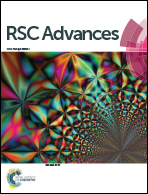Robust and economic reduction protocol employing immensely stable and leach-proof magnetically separable nanocomposites†
Abstract
Magnetically recoverable nanocomposites i.e. metal loaded over modified ferrite nanoparticles have been synthesized via a facile three step pathway. Modification of ferrite nanoparticles which serve as the core has been achieved using dopamine hydrogen chloride. Owing to this, introduction of terminal amine groups on the surface of ferrite nanoparticles takes place which provides binding sites for the stabilization of metal nanoparticles providing leach-proof nanocomposites. The synthesized nanocomposites have been characterized using various characterization techniques. Substantiation of the modification of the pristine magnetic ferrite nano particles has been done from the emergence of strong stretching vibration bands of N–H and O–H in the range of 3200–3400 cm−1, N–H stretching band in the range of 1630–1650 cm−1, C–C vibrations of the benzene ring in the range of 1480–1500 cm−1 and C–O stretching vibrations in the range of 1070–1100 cm−1. In the XRD patterns additional peaks corresponding to loaded metals (Cu and Ag) along with peaks corresponding to spinel ferrites have been observed confirming the successful formation of the composite. EDS patterns and FE-SEM elemental mapping confirmed the purity of the samples by displaying the absence of any impurity. Elemental mapping also confirmed the uniform binding of the loaded metals over the surface of modified ferrite nanoparticles. Catalytic efficiency of the synthesized nanocomposites has been explored for the reduction of nitroarenes. Both the Cu and Ag loaded samples exhibited excellent activity and efficient recyclability for the reduction of nitroarenes in the presence of NaBH4 as a reducing agent.


 Please wait while we load your content...
Please wait while we load your content...